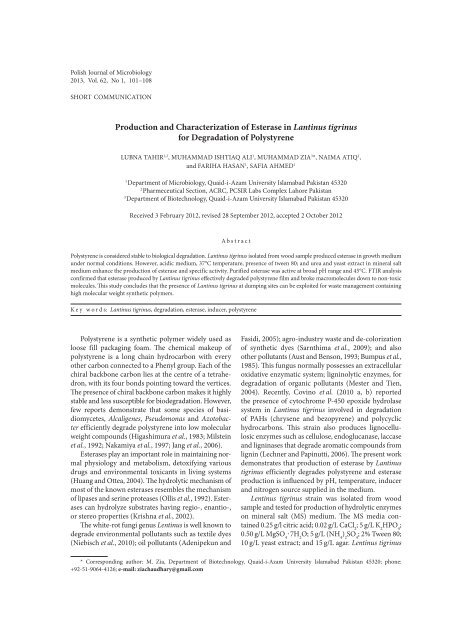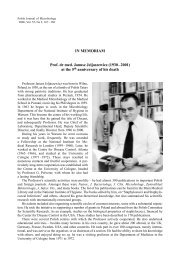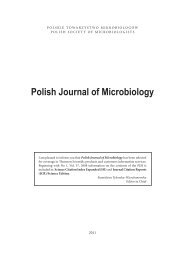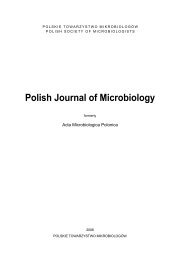Production and Characterization of Esterase in Lantinus tigrinus for ...
Production and Characterization of Esterase in Lantinus tigrinus for ...
Production and Characterization of Esterase in Lantinus tigrinus for ...
Create successful ePaper yourself
Turn your PDF publications into a flip-book with our unique Google optimized e-Paper software.
Polish Journal <strong>of</strong> Microbiology<br />
2013, Vol. 62, No 1, 101–108<br />
SHORT COMMUNICATION<br />
<strong>Production</strong> <strong>and</strong> <strong>Characterization</strong> <strong>of</strong> <strong>Esterase</strong> <strong>in</strong> Lant<strong>in</strong>us tigr<strong>in</strong>us<br />
<strong>for</strong> Degradation <strong>of</strong> Polystyrene<br />
LUBNA TAHIR 1,2 , MUHAMMAD ISHTIAQ ALI 1 , MUHAMMAD ZIA 3 *, NAIMA ATIQ 1 ,<br />
<strong>and</strong> FARIHA HASAN 1 , SAFIA AHMED 1<br />
1<br />
Department <strong>of</strong> Microbiology, Quaid-i-Azam University Islamabad Pakistan 45320<br />
2<br />
Pharmeceutical Section, ACRC, PCSIR Labs Complex Lahore Pakistan<br />
3<br />
Department <strong>of</strong> Biotechnology, Quaid-i-Azam University Islamabad Pakistan 45320<br />
Received 3 February 2012, revised 28 September 2012, accepted 2 October 2012<br />
A b s t r a c t<br />
Polystyrene is considered stable to biological degradation. Lant<strong>in</strong>us tigr<strong>in</strong>us isolated from wood sample produced esterase <strong>in</strong> growth medium<br />
under normal conditions. However, acidic medium, 37°C temperature, presence <strong>of</strong> tween 80; <strong>and</strong> urea <strong>and</strong> yeast extract <strong>in</strong> m<strong>in</strong>eral salt<br />
medium enhance the production <strong>of</strong> esterase <strong>and</strong> specific activity. Purified esterase was active at broad pH range <strong>and</strong> 45°C. FTIR analysis<br />
confirmed that esterase produced by Lant<strong>in</strong>us tigr<strong>in</strong>us effectively degraded polystyrene film <strong>and</strong> broke macromolecules down to non-toxic<br />
molecules. This study concludes that the presence <strong>of</strong> Lant<strong>in</strong>us tigr<strong>in</strong>us at dump<strong>in</strong>g sites can be exploited <strong>for</strong> waste management conta<strong>in</strong><strong>in</strong>g<br />
high molecular weight synthetic polymers.<br />
K e y w o r d s: Lant<strong>in</strong>us tigr<strong>in</strong>us, degradation, esterase, <strong>in</strong>ducer, polystyrene<br />
Polystyrene is a synthetic polymer widely used as<br />
loose fill packag<strong>in</strong>g foam. The chemical makeup <strong>of</strong><br />
polystyrene is a long cha<strong>in</strong> hydrocarbon with every<br />
other carbon connected to a Phenyl group. Each <strong>of</strong> the<br />
chiral backbone carbon lies at the centre <strong>of</strong> a tetrahedron,<br />
with its four bonds po<strong>in</strong>t<strong>in</strong>g toward the vertices.<br />
The presence <strong>of</strong> chiral backbone carbon makes it highly<br />
stable <strong>and</strong> less susceptible <strong>for</strong> biodegradation. However,<br />
few reports demonstrate that some species <strong>of</strong> basidiomycetes,<br />
Alcaligenes, Pseudomonas <strong>and</strong> Azotobacter<br />
efficiently degrade polystyrene <strong>in</strong>to low molecular<br />
weight compounds (Higashimura et al., 1983; Milste<strong>in</strong><br />
et al., 1992; Nakamiya et al., 1997; Jang et al., 2006).<br />
<strong>Esterase</strong>s play an important role <strong>in</strong> ma<strong>in</strong>ta<strong>in</strong><strong>in</strong>g normal<br />
physiology <strong>and</strong> metabolism, detoxify<strong>in</strong>g various<br />
drugs <strong>and</strong> environmental toxicants <strong>in</strong> liv<strong>in</strong>g systems<br />
(Huang <strong>and</strong> Ottea, 2004). The hydrolytic mechanism <strong>of</strong><br />
most <strong>of</strong> the known esterases resembles the mechanism<br />
<strong>of</strong> lipases <strong>and</strong> ser<strong>in</strong>e proteases (Ollis et al., 1992). <strong>Esterase</strong>s<br />
can hydrolyze substrates hav<strong>in</strong>g regio-, enantio-,<br />
or stereo properties (Krishna et al., 2002).<br />
The white-rot fungi genus Lent<strong>in</strong>us is well known to<br />
degrade environmental pollutants such as textile dyes<br />
(Niebisch et al., 2010); oil pollutants (Adenipekun <strong>and</strong><br />
Fasidi, 2005); agro-<strong>in</strong>dustry waste <strong>and</strong> de-colorization<br />
<strong>of</strong> synthetic dyes (Sarnthima et al., 2009); <strong>and</strong> also<br />
other pollutants (Aust <strong>and</strong> Benson, 1993; Bumpus et al.,<br />
1985). This fungus normally possesses an extracellular<br />
oxidative enzymatic system; lign<strong>in</strong>olytic enzymes, <strong>for</strong><br />
degradation <strong>of</strong> organic pollutants (Mester <strong>and</strong> Tien,<br />
2004). Recently, Cov<strong>in</strong>o et al. (2010 a, b) reported<br />
the presence <strong>of</strong> cytochrome P-450 epoxide hydrolase<br />
system <strong>in</strong> Lant<strong>in</strong>us tigr<strong>in</strong>us <strong>in</strong>volved <strong>in</strong> degradation<br />
<strong>of</strong> PAHs (chrysene <strong>and</strong> bezopyrene) <strong>and</strong> polycyclic<br />
hydrocarbons. This stra<strong>in</strong> also produces lignocellulosic<br />
enzymes such as cellulose, endoglucanase, laccase<br />
<strong>and</strong> lign<strong>in</strong>ases that degrade aromatic compounds from<br />
lign<strong>in</strong> (Lechner <strong>and</strong> Pap<strong>in</strong>utti, 2006). The present work<br />
demonstrates that production <strong>of</strong> esterase by Lant<strong>in</strong>us<br />
tigr<strong>in</strong>us efficiently degrades polystyrene <strong>and</strong> esterase<br />
production is <strong>in</strong>fluenced by pH, temperature, <strong>in</strong>ducer<br />
<strong>and</strong> nitrogen source supplied <strong>in</strong> the medium.<br />
Lent<strong>in</strong>us tigr<strong>in</strong>us stra<strong>in</strong> was isolated from wood<br />
sample <strong>and</strong> tested <strong>for</strong> production <strong>of</strong> hydrolytic enzymes<br />
on m<strong>in</strong>eral salt (MS) medium. The MS media conta<strong>in</strong>ed<br />
0.25 g/l citric acid; 0.02 g/L CaCl 2<br />
; 5 g/L K 2<br />
HPO 4<br />
;<br />
0.50 g/L MgSO 4<br />
. 7H2 O; 5 g/L (NH 4<br />
) 2<br />
SO 4<br />
; 2% Tween 80;<br />
10 g/L yeast extract; <strong>and</strong> 15 g/L agar. Lent<strong>in</strong>us tigr<strong>in</strong>us<br />
* Correspond<strong>in</strong>g author: M. Zia, Department <strong>of</strong> Biotechnology, Quaid-i-Azam University Islamabad Pakistan 45320; phone:<br />
+92-51-9064-4126; e-mail: ziachaudhary@gmail.com
102<br />
Tahir L. et al. 1<br />
showed clear zone <strong>of</strong> hydrolysis on plates. Furthermore,<br />
production <strong>of</strong> esterase was carried out <strong>in</strong> PYD broth<br />
medium conta<strong>in</strong><strong>in</strong>g 5 g/L peptone; 3 g/L beef extract;<br />
5 g/L sodium chloride; 5 g/L yeast extract, <strong>and</strong> 1 g/L<br />
Dextrose. The PYD media was <strong>in</strong>oculated with 10%<br />
fungal homogenate <strong>and</strong> fermented at 37°C, 150 rpm<br />
<strong>in</strong> shaker <strong>in</strong>cubator <strong>for</strong> 96 hr. Samples were collected<br />
after every 24 hr <strong>and</strong> esterase activity was per<strong>for</strong>med<br />
<strong>in</strong> cell free extract. To access esterase activity, crude<br />
enzyme was treated with 1 M ρ-nitrophenyl acetate,<br />
follow<strong>in</strong>g the procedure described by Maeda et al.<br />
(2005). The optical density was measured <strong>in</strong> spectrophotometer<br />
at 380 nm. St<strong>and</strong>ard curve was drawn by<br />
react<strong>in</strong>g crude enzyme with vary<strong>in</strong>g concentration <strong>of</strong><br />
ρ-nitophenyl (0.01–0.1 mg/ml). One unit <strong>of</strong> esterase<br />
activity is def<strong>in</strong>ed as the amount <strong>of</strong> enzyme which<br />
releases 10 µg <strong>of</strong> p-nitrophenol/ml under the st<strong>and</strong>ard<br />
assay conditions.<br />
For the morphological identification, Lant<strong>in</strong>us tigr<strong>in</strong>us<br />
was grown on malt extract media (Merck). After<br />
seven days <strong>of</strong> culture at 37°C, morphological characters<br />
were observed. For molecular identification, total<br />
genomic DNA was extracted accord<strong>in</strong>g to the method<br />
<strong>of</strong> Anderson et al. (1996) follow<strong>in</strong>g amplification <strong>of</strong> ITS<br />
regions by PCR. Universal primers ITS-1 5’-TCCG-<br />
TAGGTGAACCTGCGG-3’ <strong>and</strong> ITS-4 5’-TCCTC-<br />
CGCTTATTGATATGC-3’ were used as previously<br />
described by Webb et al. (2000). Amplified products<br />
were purified <strong>and</strong> sequenced us<strong>in</strong>g the ABI BigDye<br />
Dideoxy Term<strong>in</strong>ator Cycle sequenc<strong>in</strong>g kit (Applied Biosystems<br />
Inc., Warr<strong>in</strong>gton, United K<strong>in</strong>gdom) follow<strong>in</strong>g<br />
<strong>for</strong>ward <strong>and</strong> reverse sequences alignment us<strong>in</strong>g ABI<br />
Auto-assembler s<strong>of</strong>tware (Applied Biosystems Inc.).<br />
The overlapp<strong>in</strong>g consensus sequence was compared<br />
with sequences <strong>in</strong> the NCBI database us<strong>in</strong>g FASTA 3<br />
sequence homology searches.<br />
For production <strong>of</strong> maximum esterase, PYD medium<br />
was used as described be<strong>for</strong>e <strong>in</strong> all experiments otherwise<br />
mentioned. For pH optimization, the pH <strong>of</strong> the<br />
media was adjusted to 3, 4, 5, 6, 7, 8, 9 <strong>and</strong> 10. For<br />
temperature condition st<strong>and</strong>ardization, <strong>in</strong>oculated<br />
media (pH 5) flasks were kept on orbital shaker at 30°C,<br />
37°C <strong>and</strong> 45°C at 150 rpm. Three different substrates as<br />
<strong>in</strong>ducer (Tween 20, Tween 80, <strong>and</strong> olive oil) at 1% each<br />
were also exam<strong>in</strong>ed <strong>for</strong> enzyme production. Interaction<br />
<strong>of</strong> application <strong>of</strong> <strong>in</strong>ducer with rage <strong>of</strong> temperature<br />
(30°C, 37°C <strong>and</strong> 45°C) was also studies. For optimization<br />
<strong>of</strong> nitrogen source, M<strong>in</strong>eral medium (0.25 g/L<br />
Citric acid; 0.02 g/L CaCl 2<br />
; 5 g/L K 2<br />
HPO 4<br />
; 0.50 g/L<br />
MgSO 4 . 7H 2<br />
O) with different nitrogen sources was<br />
used. All the experiments were per<strong>for</strong>med <strong>in</strong> triplicate<br />
<strong>and</strong> samples were collected at 24 hr <strong>in</strong>tervals. Enzyme<br />
assay was per<strong>for</strong>med as mentioned be<strong>for</strong>e. Total prote<strong>in</strong><br />
was also analyzed <strong>in</strong> all samples follow<strong>in</strong>g the method<br />
described by Lowry et al. (1951).<br />
For partial purification <strong>of</strong> esterase, the culture filtrate<br />
was concentrated by 70% (NH 4<br />
) 2<br />
SO 4<br />
<strong>in</strong> 50 mM Tris<br />
HCL buffer (pH 8). Concentrated esterase was dialyzed<br />
by ultra-filtration (dialyzed by us<strong>in</strong>g 12000 M.W cut<br />
<strong>of</strong>f dialyz<strong>in</strong>g bag) <strong>and</strong> chromatographed us<strong>in</strong>g Sephadex<br />
G-75, eluted with 50 mM tris HCl buffer, pH 8.<br />
A volume <strong>of</strong> 3 ml fraction was collected <strong>and</strong> assayed<br />
<strong>for</strong> enzyme activity <strong>and</strong> amount <strong>of</strong> prote<strong>in</strong>. The procedure<br />
<strong>for</strong> enzyme assay as def<strong>in</strong>ed be<strong>for</strong>e was followed<br />
<strong>for</strong> the degradation <strong>of</strong> plastics except that <strong>in</strong>stead <strong>of</strong><br />
ρ-nitophenyl acetate 0.1% polystyrene film was <strong>in</strong>cubated<br />
at 37°C. After 72 hr <strong>of</strong> <strong>in</strong>cubation, the films were<br />
removed <strong>and</strong> thoroughly washed with distilled water.<br />
Degradation <strong>of</strong> the film surface was <strong>in</strong>itially exam<strong>in</strong>ed<br />
microscopically follow<strong>in</strong>g FTIR spectroscopic<br />
analysis <strong>in</strong> an Analect RFX-75 spectrometer through<br />
st<strong>and</strong>ard protocol.<br />
Growth <strong>of</strong> Lent<strong>in</strong>us tigr<strong>in</strong>us <strong>in</strong> m<strong>in</strong>eral salt medium<br />
produced hydrolytic enzyme. The clear region <strong>in</strong> agar<br />
conta<strong>in</strong><strong>in</strong>g petri plates confirmed release <strong>of</strong> enzyme <strong>in</strong><br />
the medium under normal conditions. Colonies <strong>of</strong> the<br />
stra<strong>in</strong> were light colored, smooth <strong>and</strong> flat on the surface<br />
with sporous appearance. The isolate was identified by<br />
5.8S, 18S, 28S rRNA <strong>in</strong>ternal transcribed spacer (ITS)<br />
region sequenc<strong>in</strong>g. Sequences were compared with<br />
known sequences <strong>and</strong> deposited to NCBI with accession<br />
number EU543989. Increase <strong>in</strong> pH from acidic<br />
to basic decreased production <strong>and</strong> specific activity <strong>of</strong><br />
esterase (Fig. 1). Maximum esterase production <strong>and</strong><br />
specific activity was observed on 4 th day when cultured<br />
at acidic medium. However; at pH 7 <strong>and</strong> 8, maximum<br />
activity was observed on 5 th day <strong>of</strong> culture. Lant<strong>in</strong>us<br />
tigr<strong>in</strong>us also prefered neutral to acidic condition <strong>for</strong><br />
production <strong>of</strong> esterase like other esterase produc<strong>in</strong>g<br />
microbes (Buzz<strong>in</strong>i <strong>and</strong> Mart<strong>in</strong>i, 2002; Kudanga et al.,<br />
2007). At 30°C, esterase production gradually <strong>in</strong>creased<br />
up to 5 th day <strong>of</strong> culture (Fig. 2). However, 37°C was<br />
found optimum <strong>for</strong> production <strong>of</strong> esterase. At this<br />
temperature maximum esterase production (10 U/ml)<br />
<strong>and</strong> maximum specific activity (0.4 μg/ml prote<strong>in</strong>) was<br />
atta<strong>in</strong>ed on 5 th day <strong>of</strong> culture. At all the temperatures,<br />
production <strong>and</strong> specific activity drastically decreased<br />
when culture was <strong>in</strong>cubated <strong>for</strong> more then five days.<br />
Maximum esterase production from Aureobasidium<br />
pullulans has been reported at 35°C <strong>and</strong> its production<br />
decreased with <strong>in</strong>crease <strong>of</strong> cultur<strong>in</strong>g temperature<br />
(Kudanga et al., 2007).<br />
Tween 80 had a positive role <strong>in</strong> production <strong>of</strong> esterase<br />
(Fig. 3). In all the cases esterase production <strong>and</strong><br />
specific activity was maximum at 37°C as compared<br />
with 30 <strong>and</strong> 45°C. Tween 20 was also found better<br />
<strong>for</strong> production <strong>of</strong> esterase at 30 <strong>and</strong> 37°C. However,<br />
<strong>in</strong> the presence <strong>of</strong> tween 80 specific esterase activity<br />
was higher. The results also describe that Lant<strong>in</strong>us<br />
tigr<strong>in</strong>us does not prefer the presence <strong>of</strong> fatty acids
1 Short communication<br />
103<br />
Fig. 1. Effect <strong>of</strong> different pH <strong>in</strong>duc<strong>in</strong>g esterase production by Lant<strong>in</strong>us tigr<strong>in</strong>us.<br />
(A) pH 3.0; (B) pH 4.0; (C) pH 5.0; (D) pH 6.0; (E) pH 7.0; (F) pH 8.0; (G) pH 9.0; (H) pH 10.0, enzyme activity is expressed <strong>in</strong> U/ml<br />
<strong>and</strong> specific activity <strong>in</strong> μg/ml prote<strong>in</strong>.
104<br />
Tahir L. et al. 1<br />
Fig. 2. Effect <strong>of</strong> different temperature <strong>in</strong>duc<strong>in</strong>g esterase<br />
production by Lant<strong>in</strong>us tigr<strong>in</strong>us.<br />
(A) 30°C; (B) 37°C; (C) 45°C, enzyme activity is expressed <strong>in</strong> U/ml<br />
<strong>and</strong> specific activity <strong>in</strong> μg/ml prote<strong>in</strong>.<br />
(olive oil) <strong>for</strong> production <strong>of</strong> esterase. The presence<br />
<strong>of</strong> surfactants <strong>in</strong>creases cell membrane permeability,<br />
<strong>in</strong>creas<strong>in</strong>g the adsorption <strong>of</strong> nutrients <strong>and</strong> release <strong>of</strong><br />
enzyme (Okagbue et al., 2001), substrate mobility<br />
(Marcozzi et al., 1998); <strong>and</strong> enhance better dispersion<br />
<strong>of</strong> the lipodal substrate which facilitates better utiliza-<br />
Fig. 3.
1 Short communication<br />
105<br />
Fig. 3. Effect <strong>of</strong> different <strong>in</strong>ducers <strong>in</strong>duc<strong>in</strong>g esterase production by<br />
Lant<strong>in</strong>us tigr<strong>in</strong>us.<br />
(A) Tween20 at 30°C; (B) Tween20 at 37°C; (C) Tween20 at 45°C;<br />
(D) Tween80 at 30°C; (E) Tween80 at 37°C; (F) Tween80 at 45°C;<br />
(G) olive oil at 30°C; (H) olive oil at 37°C; (I) olive oil at 45°C, enzyme<br />
activity is expressed <strong>in</strong> U/ml <strong>and</strong> specific activity <strong>in</strong> μg/ml prote<strong>in</strong>.<br />
Fig. 3.<br />
tion by the enzyme (Arthur et al., 1984). Kudanga et al.<br />
(2007) <strong>and</strong> Okagbue et al. (2001) also reported positive<br />
<strong>in</strong>fluence <strong>of</strong> Tween 80 <strong>for</strong> production <strong>of</strong> esterase <strong>and</strong><br />
α-glucosidase, respectively. The maximum esterase production<br />
(38.62 U/ml) <strong>and</strong> specific activity (0.85 μg/ml<br />
prote<strong>in</strong>) was achieved when cultured <strong>in</strong> the presence<br />
<strong>of</strong> urea <strong>and</strong> yeast extract (Fig. 4). Replac<strong>in</strong>g the urea<br />
with ammonium sulfate decreased both production<br />
<strong>and</strong> specific activity <strong>of</strong> esterase. Other nitrogen sources<br />
did not positively <strong>in</strong>fluence the production <strong>of</strong> esterase.<br />
It can be stated that maximum esterase production<br />
through Lant<strong>in</strong>us tigr<strong>in</strong>us can be achieved by provid<strong>in</strong>g<br />
organic nitrogen sources. However, the production<br />
<strong>of</strong> enzyme <strong>in</strong> the presence <strong>of</strong> different nitrogen source<br />
also depends upon fungal stra<strong>in</strong> (Kudanga et al., 2007).<br />
Lent<strong>in</strong>us tigr<strong>in</strong>us purified esterase was optimally<br />
active at 45°C <strong>and</strong> pH 9. At 25, 30 <strong>and</strong> 35°C, m<strong>in</strong>ute<br />
esterase activity (< 1.0 μg/ml prote<strong>in</strong>) was observed.<br />
The esterase activity reached at maximum (4.1 μg/ml<br />
prote<strong>in</strong>) at 45°C <strong>and</strong> gradually decreased when temperature<br />
was <strong>in</strong>creased up to 50 <strong>and</strong> 55°C. Blum et al.<br />
reported optima temperature 30°C <strong>for</strong> production <strong>of</strong><br />
maximum acetyl xylan esterase from rumen fungus<br />
Orp<strong>in</strong>omyces sp. stra<strong>in</strong> PC-2 (Blum et al., 1999). At<br />
acidic pH (4, 5) the activity was < 0.4 μg/ml prote<strong>in</strong><br />
<strong>and</strong> it <strong>in</strong>creased up to maximum (4.8 μg/ml prote<strong>in</strong>)<br />
at pH 9. Loss <strong>of</strong> enzymatic activities at different pH<br />
<strong>and</strong> temperature have been reported <strong>and</strong> found that<br />
vary<strong>in</strong>g the assay conditions the enzyme activity may<br />
be sudden lost or m<strong>in</strong>ute activity may be observed<br />
(Topakas et al., 2007). The half life <strong>of</strong> the enzyme also<br />
varies by vary<strong>in</strong>g the temperature <strong>and</strong> pH condition<br />
either dur<strong>in</strong>g production or dur<strong>in</strong>g assay (Ewis et al.,<br />
2004). However, many scientists reported that esterases
106<br />
Tahir L. et al. 1<br />
Fig. 4. Effect <strong>of</strong> different nitrogen source <strong>in</strong>duc<strong>in</strong>g esterase production by Lant<strong>in</strong>us tigr<strong>in</strong>us.<br />
(A) yeast extract; (B) urea <strong>and</strong> yeast extract; (C) meat extract; (D) yeast extract <strong>and</strong> (NH 4<br />
) 2<br />
SO 4<br />
; (E) peptone; (F) KNO 3<br />
; (G) (NH 4<br />
) 2<br />
SO 4<br />
; (H) yeast<br />
extract <strong>and</strong> KNO 3<br />
, enzyme activity is expressed <strong>in</strong> U/ml <strong>and</strong> specific activity <strong>in</strong> μg/ml prote<strong>in</strong>.
1 Short communication<br />
107<br />
Fig. 5. FTIR analysis <strong>of</strong> polystyrene film.<br />
(A) be<strong>for</strong>e treatment; (B) after treatment <strong>of</strong> esterase isolated from Lant<strong>in</strong>us tigr<strong>in</strong>us.<br />
produced by different bacterial <strong>and</strong> fungal isolates have<br />
optimum temperature 37°C <strong>and</strong> basic pH conditions<br />
(Suzuki et al., 2004). The pH <strong>of</strong> the medium <strong>in</strong> which<br />
the enzyme is exposed also affects the ionization state <strong>of</strong><br />
its am<strong>in</strong>o acids which dictate the primary <strong>and</strong> secondary<br />
structure <strong>of</strong> the enzyme, thus controll<strong>in</strong>g its activity.<br />
The <strong>in</strong>fluence <strong>of</strong> pH <strong>of</strong> the cultivation medium may<br />
be directly related with the stability <strong>of</strong> enzymes (Ueda<br />
et al., 1982). The polystyrene film treated with purified<br />
esterase confirmed degradation <strong>of</strong> polystyrene surface<br />
(Fig. 5). FTIR spectroscopy analysis (Fig. 5A) revealed<br />
that aromatic peaks (1449, 1493 <strong>and</strong> 1601 cm-1), alkane<br />
(1026–1369 cm-1) <strong>and</strong> C-H stretch (2850–3060 cm-1)<br />
are reduced <strong>in</strong> Fig. 5(B). This shows that esterase breaks<br />
down the bonds between small units <strong>of</strong> styrene <strong>and</strong> also<br />
degrades alkanes <strong>and</strong> aromatic r<strong>in</strong>gs. Generally, polystyrene<br />
is considered a stable macromolecule (Zheng<br />
et al., 2005); however, long but simple chemical structure<br />
<strong>and</strong> small molecular weight polymer made it easy<br />
to be degraded by enzymatic hydrolysis. Many studies<br />
reveal that polystyrene <strong>and</strong> other stable polymers can be<br />
degraded by different enzymes (Takamoto et al., 2001;<br />
Chattopadhyay <strong>and</strong> Madras, 2003).<br />
This study concludes that Lant<strong>in</strong>us tigr<strong>in</strong>us releases<br />
esterase enzyme <strong>in</strong> the culture medium. <strong>Production</strong> <strong>and</strong><br />
release <strong>of</strong> esterase was <strong>in</strong>fluenced by temperature, pH,<br />
nitrogen source <strong>and</strong> <strong>in</strong>ducer. The enzyme was active<br />
at 45°C <strong>and</strong> basic medium was optimum <strong>for</strong> its activity.<br />
FTIR analysis confirms degradation <strong>of</strong> polystyrene<br />
by reduction <strong>in</strong> peak wavelength. The results presented<br />
<strong>in</strong> this study can be further exploited <strong>for</strong> environ mental<br />
waste management especially when conta<strong>in</strong><strong>in</strong>g synthetic<br />
polymers such as polystyrene.<br />
Literature<br />
Adenipekun C.O. <strong>and</strong> I.O. Fasidi. 2005. Bioremediation <strong>of</strong> oilpolluted<br />
soil by Lent<strong>in</strong>us subnudus, A Nigerian white-rot fungus.<br />
African J. Biotechnol. 4: 796–798<br />
Anderson M.J., K. Gull <strong>and</strong> D.W. Denn<strong>in</strong>g. 1996. Molecular typ<strong>in</strong>g<br />
by r<strong>and</strong>om amplification <strong>of</strong> polymorphic DNA <strong>and</strong> m13 southern
108<br />
Tahir L. et al. 1<br />
hybridization <strong>of</strong> related paired isolates <strong>of</strong> Aspergillus fumigatus.<br />
J. Cl<strong>in</strong>. Microbiol. 34: 87–93<br />
Arthur G., W.T. Stanley <strong>and</strong> C.C. Patrick. 1984. The effects <strong>of</strong><br />
detergents on CDP-chol<strong>in</strong>e: 1,2-diacylglycerol phosphochol<strong>in</strong>e<br />
transferase from hamster heart. Canadian J. Biochem. Cell. Biol. 62:<br />
1059–1063<br />
Aust S.D. <strong>and</strong> J.T. Benson. 1993. The fungus among us – use <strong>of</strong><br />
white-rot fungi to biodegrade environmental-pollutants. Environ.<br />
Health Perspec. 101: 232–233<br />
Blum D.L., L. X<strong>in</strong>-Liang, C. Huizhong <strong>and</strong> G.L. Lars. 1999. <strong>Characterization</strong><br />
<strong>of</strong> an acetyl xylan esterase from the anaerobic fungus<br />
Orp<strong>in</strong>omyces sp. stra<strong>in</strong> PC-2. App. Environ. Microbiol. 9: 3990–3995<br />
Bumpus J.A., M. Tien, D. Wright <strong>and</strong> S.D. Aust. 1985. Oxidation<br />
<strong>of</strong> persistent environmental-pollutants by a white rot fungus. Science<br />
228: 1434–1436<br />
Buzz<strong>in</strong>i P. <strong>and</strong> A. Mart<strong>in</strong>i. 2002. Extracellular enzymatic activity<br />
pr<strong>of</strong>iles <strong>in</strong> yeast <strong>and</strong> yeast like stra<strong>in</strong>s isolated from tropical environments.<br />
J. App. Microbiol. 93: 1020–1025<br />
Chattopadhyay S. <strong>and</strong> G. Madras. 2003. K<strong>in</strong>etics <strong>of</strong> the enzymatic<br />
degradation <strong>of</strong> poly(V<strong>in</strong>yl Acetate) <strong>in</strong> solution. J. Appl. Polymer Sci.<br />
89: 2579–2582<br />
Cov<strong>in</strong>o S., M. Cvancarova, M. Muzikar, K. Svobodova,<br />
A. D’annibale, M. Petruccioli, F. Federici, Z. Kres<strong>in</strong>ova <strong>and</strong><br />
T. Cajthaml. 2010a. An efficient PAH-degrad<strong>in</strong>g Lent<strong>in</strong>us (Panus)<br />
Tigr<strong>in</strong>us stra<strong>in</strong>: Effect <strong>of</strong> <strong>in</strong>oculum <strong>for</strong>mulation <strong>and</strong> pollutant bioavailability<br />
<strong>in</strong> solid matrices. J. Hazard. Mat. 183: 669–676<br />
Cov<strong>in</strong>o S., K. Svobodova, A. D’Annibale, M. Cvancarova,<br />
M. Petruccioli <strong>and</strong> F. Federici. 2010b. Effect <strong>of</strong> <strong>in</strong>oculum <strong>for</strong>mulation<br />
<strong>and</strong> contam<strong>in</strong>ant bioavailability on PHA degradation per<strong>for</strong>mances<br />
<strong>of</strong> Lent<strong>in</strong>us tigr<strong>in</strong>us on contam<strong>in</strong>ated solid matrices.<br />
J. Biotechnol. 150: S225–S225<br />
Ewis H.E., A.T. Abdelal <strong>and</strong> C.D. Lu. 2004. Molecular clon<strong>in</strong>g <strong>and</strong><br />
characterization <strong>of</strong> two thermostable carboxyl esterases from Geobacillus<br />
stearothermophilus. Gene 329: 187–195<br />
Higashimura T., M. Sawamoto, T. Hiza, M. Karaiwa, A. Tsuchii,<br />
T. Suzuki. 1983. Effect <strong>of</strong> methyl substitution on microbial degradation<br />
<strong>of</strong> l<strong>in</strong>ear styrene dimers by two soil bacteria. App. Environ.<br />
Microbiol. 46: 386–391<br />
Huang H.Z. <strong>and</strong> J.A. Ottea. 2004. Development <strong>of</strong> pyrethroid<br />
substrates <strong>for</strong> esterases associated with pyrethroid resistance <strong>in</strong> the<br />
tobacco budworm, Heliothis virescens (F.). J. Agri. Food Chem. 52:<br />
6539–6545<br />
Jang J.H., M. Hirai <strong>and</strong> M. Shoda. 2006. Enhancement <strong>of</strong> styrene<br />
removal efficiency <strong>in</strong> bi<strong>of</strong>ilter by mixed cultures <strong>of</strong> Pseudomonas<br />
Sp. SR-5. J. Biosci. Bioeng<strong>in</strong>. 102: 53–59<br />
Krishna S.H., M. Persson <strong>and</strong> U.T. Bornscheuer. 2002. Enantioselective<br />
transesterification <strong>of</strong> a tertiary alcohol by lipase a from<br />
C<strong>and</strong>ida antarctica. Tetrahedron Asymmetry 13: 2693–2696<br />
Kudanga T., E. Mwenje, F. M<strong>and</strong>ivenga <strong>and</strong> J.S. Read. 2007. <strong>Esterase</strong>s<br />
<strong>and</strong> putative lipases from tropical isolates <strong>of</strong> Aureobasidium<br />
pullulans. J. Basic. Microbiol. 47: 138–147<br />
Lechner B.E. <strong>and</strong> V.L. Pap<strong>in</strong>utti. 2006. <strong>Production</strong> <strong>of</strong> Lignocellulosic<br />
enzymes dur<strong>in</strong>g growth <strong>and</strong> fruit<strong>in</strong>g <strong>of</strong> the rdible fungus<br />
Lent<strong>in</strong>us tigr<strong>in</strong>us on wheat straw. Process Biochem. 41: 594–598<br />
Lowry O.H., H.J. Rosebrough, A.L. Farr <strong>and</strong> R.J. R<strong>and</strong>all. 1951.<br />
Prote<strong>in</strong> measurement with the fol<strong>in</strong>-phenol reagents. J. Biol. Chem.<br />
193: 265–275<br />
Maeda H., Y. Yamagata, K. Abe, F. Hasegawa, M. Machida,<br />
R. Ishioka, G. Katsuya <strong>and</strong> N. Tasuku. 2005. Purification <strong>and</strong><br />
characterization <strong>of</strong> a biodegradable plastic-degrad<strong>in</strong>g enzyme from<br />
Aspergillus Oryzae. App. Microbiol. Biotechnol. 67: 778–788<br />
Marcozzi C., I.D.J. Burdett, R.S. Buxton <strong>and</strong> A.I. Magee. 1998.<br />
Expression <strong>of</strong> both types <strong>of</strong> desmosomal cadher<strong>in</strong>s <strong>and</strong> plakoglob<strong>in</strong><br />
confers strong <strong>in</strong>tercellular adhesion. J. Cell Sci. 111: 495–509<br />
Mester T. <strong>and</strong> M. Tien. 2004. Oxidation mechanism <strong>of</strong> lign<strong>in</strong>olytic<br />
enzymes <strong>in</strong>volved <strong>in</strong> the degradation <strong>of</strong> environmental pollutants.<br />
Inter. J. Biodeterior. Biodegrad. 6: 51–59<br />
Milste<strong>in</strong> O., R. Gersonde, A. Huttermann, M.J. Chen <strong>and</strong><br />
J.J. Meister. 1992. Fungal biodegradation <strong>of</strong> lignopolystyrene graftcopolymers.<br />
App. Environ. Microbiol. 58: 3225–3232<br />
Nakamiya K., S. Ooi <strong>and</strong> T. K<strong>in</strong>oshita. 1997. Non-Heme hydroqu<strong>in</strong>one<br />
peroxidase from Azotobacter beijer<strong>in</strong>ckii Hm121. J. Ferment.<br />
Bioeng<strong>in</strong>. 84: 14–21<br />
Niebisch C.H., M.A. Knoll, S. Ruth, R. Schadeck, D.A. Mitchell,<br />
V. Kava-Cordeiro <strong>and</strong> J. Paba. 2010. Decolorization <strong>and</strong> biodegradation<br />
<strong>of</strong> reactive blue 220 textile dye by Lent<strong>in</strong>us cr<strong>in</strong>itus extracellular<br />
extract. J. Hazard. Mat. 180: 316–322<br />
Okagbue R.N., E. Mwenje, T. Kudanga, M. Siwela <strong>and</strong> T. Sib<strong>and</strong>a.<br />
2001. Isolation <strong>of</strong> Aureobasidium pullulans from Zimbabwean<br />
sources <strong>and</strong> glucosidase activities <strong>of</strong> selected isolates. South African<br />
J. Bot. 67: 157–160<br />
Ollis D.l., E. Cheah, M. Cygler, B. Dijkstra, F. Frolow, S.M. Franken,<br />
M. Harel, S.I. Rem<strong>in</strong>gton, I. Silman, J. Schrag, J.I. Sussman,<br />
K.H.G. Verschueren <strong>and</strong> A. Goldman. 1992. The alpha/beta-hydrolase<br />
fold. Prote<strong>in</strong> Eng<strong>in</strong>. 5: 197–211<br />
Sarnthima R., K. Saranyu <strong>and</strong> S. Jisnuson. 2009. Extracellular lign<strong>in</strong>olytic<br />
enzymes by Lent<strong>in</strong>us polychrous LeVol. under solid-state<br />
fermentation <strong>of</strong> potential agro-<strong>in</strong>dustrial wastes <strong>and</strong> their effectiveness<br />
<strong>in</strong> decolorization <strong>of</strong> synthetic dyes. Biotechnol. Bioprocess<br />
Eng<strong>in</strong>eer. 14: 513–522<br />
Suzuki Y., K. Miyamoto <strong>and</strong> H. Ohta. 2004. A novel thermostable<br />
esterase from the thermoacidophilic archaeon Sulfolobus tokodaii<br />
stra<strong>in</strong> 7. FEMS Microbiol. Lett. 236: 97–102<br />
Takamoto T., P. Kerep, H. Uyama <strong>and</strong> S. Kobayashi. 2001. Lipasecatalyzed<br />
transesterification <strong>of</strong> polyesters to ester copolymers. Macromol.<br />
Biosci. 1: 223–227<br />
Topakas E., C. Vafiadi, P. Christakopoulos. 2007. Microbial production,<br />
characterization <strong>and</strong> applications <strong>of</strong> feruloyl esterases.<br />
Process Biochem. 42: 497–509<br />
Ueda S., Y. Fujio <strong>and</strong> J.Y. Lim. 1982. <strong>Production</strong> <strong>and</strong> some properties<br />
<strong>of</strong> pectic enzymes from Aspergillus oryzae A-3. J. App. Biochem.<br />
4: 524–532<br />
Webb J.S., M. Nixon, I.M. Eastwood, M. Greenhalgh, G.D. Robson<br />
<strong>and</strong> P.S. H<strong>and</strong>ley. 2006. Fungal colonization <strong>and</strong> biodeterioration<br />
<strong>of</strong> plasticized polyv<strong>in</strong>yl chloride. App. Environ. Microbiol. 66:<br />
3194–3200<br />
Zheng Y., E.K. Yanful <strong>and</strong> A.S. Bassi. 2005. A review <strong>of</strong> plastic<br />
waste biodegradation. Crit. Rev. Biotechnol. 25: 43–250






